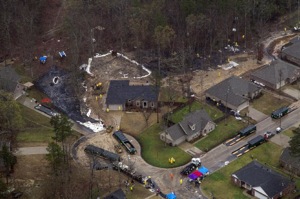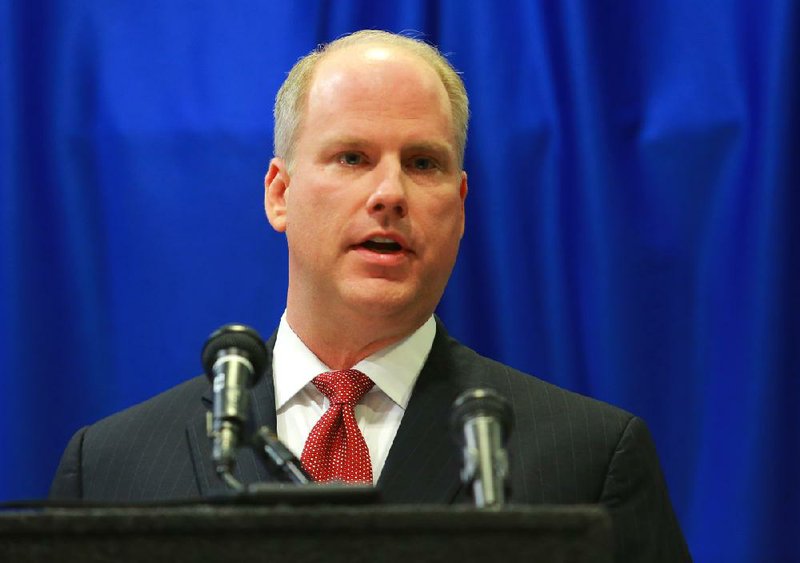Arkansas Attorney General Dustin McDaniel said Tuesday that he hopes Exxon Mobil will move faster than it did in 2010 as it analyzes an in-line inspection that took place less than two months before the company’s Pegasus pipeline ruptured in a Mayflower neighborhood.

The previous inspection took almost two years before Exxon Mobil completed a report analyzing the results, McDaniel told the Arkansas Democrat-Gazette.
“To my knowledge, at this point there is no analysis or conclusion” based on the more recent inspection in February, McDaniel said. “We’ve been given no estimate of when to expect it.”
The February inspection is significant because the rupture occurred such a short time later - on March 29. The results will likely indicate whether the test accurately detected the defects that later caused the rupture. Failure to detect them could suggest the test Exxon Mobil was using was inadequate.
If there’d been no recent accident, two years to wait for such results might be appropriate, McDaniel said. But when a rupture such as this one has happened, the company should try to move faster, he said. Doing so, he said, would be in “the best interests” of Arkansans.
John Tynan, watershed-protection manager for Central Arkansas Water, said late Tuesday that Exxon Mobil has not given the utility even raw data from the February and 2010 inspections.
The utility and several Arkansas public officials have repeatedly asked Exxon Mobil to release those inspections, a 2006 hydrostatic test of the pipeline and a roughly 250-page report by a laboratory that examined the damaged pipe segment from the March rupture. Exxon Mobil has declined, saying the decision on what to release and when to release it is up to the federal Pipeline and Hazardous Materials Safety Administration, not the company.
Central Arkansas Water obtains drinking water from Lake Maumelle for roughly 400,000 Arkansans. About 13.5 miles of the Pegasus pipeline run through the lake’s watershed.
McDaniel noted that the 850-mile-long pipeline, built in 1947 and 1948, runs through 21 watersheds in Arkansas alone.
“It’s not just Lake Maumelle,” he said.
Exxon Mobil Corp. spokesman Aaron Stryk said Tuesday that February results will be available much sooner than those from 2010 were. “The final results for the 2013 [in-line inspection] will be available in the coming months … not years,” he said in an email.
But to date, the report from the 2010 inspection has never been released to the public. And it is unclear whether the report from the 2013 inspection will be made public.
Also Tuesday, Arkansas’ U.S. senators, Democrat Mark Pryor and Republican John Boozman, and the congressman representing Arkansas’ 2nd District, Republican Rep. Tim Griffin, sent a letter to the pipeline regulatory agency and urged it to release more information about the spill.
“After repeatedly dodging the question, Exxon Mobil this week claimed that [the federal agency] is the only one with the authority to release the requested information,” the officials’ news release said.
In the letter, the three wrote: “We believe that in the interest of full transparency,[the agency] should publish on its website the Exxon-Mobil 2010 and 2013 in-line inspection reports, the 2006 hydrostatic test report, and the 2013 metallurgical report. If [the administration] cannot take this action, we would like to know the statutory requirement preventing [the agency] from acting in the public interest.
“The citizens of Arkansas have a right to know the results of these tests. Thank you for your immediate attention to this matter,” they added.
McDaniel has obtained such information from Exxon Mobil through subpoenas and said he should not be the one to release it.
His office, however, is reviewing the data to see whether there were any “indicators” suggesting the pipeline had problems before it ruptured. He would not go into detail on what might already have been determined because he said the review is still under way. Further, he said, any such information could be used as evidence during the trial of a federal lawsuit he and U.S. Attorney Christopher Thyer filed in June against Exxon Mobil.
On whether the aging pipeline should be retired rather than restarted, McDaniel said he thought that “should be seriously considered. But at this point, it would be premature to say that’s necessary.”
The pipe spilled an estimated 210,000 gallons of heavy crude oil, which had been diluted with condensates so the thick oil could flow through the pipeline running from Illinois to the Texas Gulf Coast. Government records indicate that the carcinogen benzene was in the mixture, known as diluted bitumen.
Authorities have said the oil flowed through part of the Northwoods subdivision before entering a ditch, a creek and finally a cove of Lake Conway. Thanks to a manmade barrier installed in the hours after the spill, the oil did not reach the main portion of the popular fishing lake, authorities said.
Stryk said that barrier was removed in mid-May “but we have several layers of boom in place just as a precaution.”
McDaniel would not speculate on whether any of the heavy oil might have sunk to the bottom of the cove - a concern expressed previously by Gov. Mike Beebe. Authorities saw such a problem during a larger 2010 pipeline spill that involved diluted bitumen in Michigan.
The oil in Michigan sank to the bottom of the Kalamazoo River, making the cleanup far more difficult. The U.S. Environmental Protection Agency said in a release posted on its website Tuesday that the pipeline’s owner, Enbridge Energy Partners LLP, has begun a new round of dredging in the river, upon the EPA’s order, and is supposed to have it completed by year’s end.
But even if Exxon Mobil does a great job cleaning up the Mayflower neighborhood and the cove, McDaniel said, “There’s going to be residual oil in the area for years.”
McDaniel, a sportsman who said he loves fishing in Arkansas, said he would not fish from the Lake Conway cove at this time. He cited two reasons - safety and not wanting to get in the way of workers at the site.
“I think common sense would say, ‘Don’t go fishing in the part where the cleanup is taking place,’” he said.
He said, though, that he would defer to the Arkansas Game and Fish Commission on fish-safety issues. A commission spokesman has previously said the cove is not a heavily fished area.
McDaniel said he also was concerned about health effects on some residents who did not evacuate their homes after the spill.
“There are citizens who have been in that area who [complain that] they or their children … are suffering health effects,” he said. Those complaints should be taken seriously, he said.
McDaniel also addressed a matter that’s long been one of speculation - why he and Thyer filed the lawsuit so quickly.
An out-of-state law firm representing some businesses in Mayflower had given the government 60 days to sue under the Clean Water Act. If McDaniel did not do so by that deadline, he said, the private interests could sue under the federal act if they did not believe the government was acting fast enough. The private interests would then have had more control over the lawsuit than his or Thyer’s offices would have.
He and Thyer filed the complaint on June 13, one day before the deadline, McDaniel said.
“So our timing was not determined by us,” he said.
Front Section, Pages 1 on 07/31/2013

